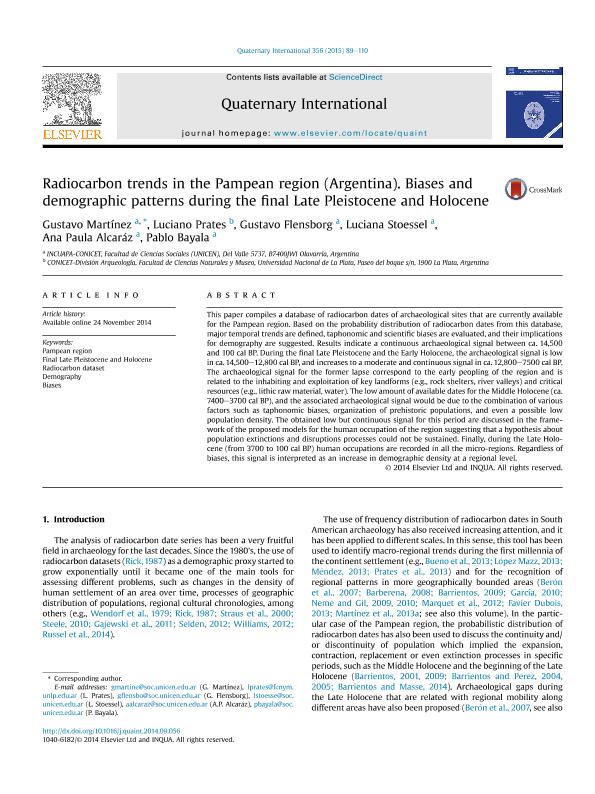Mostrar el registro sencillo del ítem
dc.contributor.author
Martínez, Gustavo
dc.contributor.author
Prates, Luciano Raúl

dc.contributor.author
Flensborg, Gustavo Ariel

dc.contributor.author
Stoessel, Luciana

dc.contributor.author
Alcaraz, Ana Paula

dc.contributor.author
Bayala, Pablo Darío

dc.date.available
2018-03-02T18:17:27Z
dc.date.issued
2015-01
dc.identifier.citation
Martínez, Gustavo; Prates, Luciano Raúl; Flensborg, Gustavo Ariel; Stoessel, Luciana; Alcaraz, Ana Paula; et al.; Radiocarbon trends in the pampean region (Argentina). biases and Demographic patterns during the final late pleistocene and holocene; Pergamon-Elsevier Science Ltd; Quaternary International; 356; 1-2015; 89-110
dc.identifier.issn
1040-6182
dc.identifier.uri
http://hdl.handle.net/11336/37665
dc.description.abstract
This paper compiles a database of radiocarbon dates of archaeological sites that are currently available for the Pampean region. Based on the probability distribution of radiocarbon dates from this database, major temporal trends are defined, taphonomic and scientific biases are evaluated, and their implications for demography are suggested. Results indicate a continuous archaeological signal between ca. 14,500 and 100calBP. During the final Late Pleistocene and the Early Holocene, the archaeological signal is low in ca. 14,500-12,800calBP, and increases to a moderate and continuous signal in ca. 12,800-7500calBP. The archaeological signal for the former lapse correspond to the early peopling of the region and is related to the inhabiting and exploitation of key landforms (e.g., rock shelters, river valleys) and critical resources (e.g., lithic raw material, water). The low amount of available dates for the Middle Holocene (ca. 7400-3700calBP), and the associated archaeological signal would be due to the combination of various factors such as taphonomic biases, organization of prehistoric populations, and even a possible low population density. The obtained low but continuous signal for this period are discussed in the framework of the proposed models for the human occupation of the region suggesting that a hypothesis about population extinctions and disruptions processes could not be sustained. Finally, during the Late Holocene (from 3700 to 100calBP) human occupations are recorded in all the micro-regions. Regardless of biases, this signal is interpreted as an increase in demographic density at a regional level.
dc.format
application/pdf
dc.language.iso
eng
dc.publisher
Pergamon-Elsevier Science Ltd

dc.rights
info:eu-repo/semantics/openAccess
dc.rights.uri
https://creativecommons.org/licenses/by-nc-nd/2.5/ar/
dc.subject
Biases
dc.subject
Demography
dc.subject
Final Late Pleistocene And Holocene
dc.subject
Pampean Region
dc.subject
Radiocarbon Dataset
dc.subject.classification
Historia

dc.subject.classification
Historia y Arqueología

dc.subject.classification
HUMANIDADES

dc.title
Radiocarbon trends in the pampean region (Argentina). biases and Demographic patterns during the final late pleistocene and holocene
dc.type
info:eu-repo/semantics/article
dc.type
info:ar-repo/semantics/artículo
dc.type
info:eu-repo/semantics/publishedVersion
dc.date.updated
2018-03-02T13:58:30Z
dc.journal.volume
356
dc.journal.pagination
89-110
dc.journal.pais
Estados Unidos

dc.journal.ciudad
Amsterdam
dc.description.fil
Fil: Martínez, Gustavo. Consejo Nacional de Investigaciones Científicas y Técnicas. Centro Científico Tecnológico Conicet - Tandil. Investigaciones Arqueológicas y Paleontológicas del Cuaternario Pampeano. Universidad Nacional del Centro de la Provincia de Buenos Aires. Investigaciones Arqueológicas y Paleontológicas del Cuaternario Pampeano; Argentina
dc.description.fil
Fil: Prates, Luciano Raúl. Universidad Nacional de La Plata. Facultad de Ciencias Naturales y Museo. División Arqueología; Argentina. Consejo Nacional de Investigaciones Científicas y Técnicas; Argentina
dc.description.fil
Fil: Flensborg, Gustavo Ariel. Consejo Nacional de Investigaciones Científicas y Técnicas. Centro Científico Tecnológico Conicet - Tandil. Investigaciones Arqueológicas y Paleontológicas del Cuaternario Pampeano. Universidad Nacional del Centro de la Provincia de Buenos Aires. Investigaciones Arqueológicas y Paleontológicas del Cuaternario Pampeano; Argentina
dc.description.fil
Fil: Stoessel, Luciana. Consejo Nacional de Investigaciones Científicas y Técnicas. Centro Científico Tecnológico Conicet - Tandil. Investigaciones Arqueológicas y Paleontológicas del Cuaternario Pampeano. Universidad Nacional del Centro de la Provincia de Buenos Aires. Investigaciones Arqueológicas y Paleontológicas del Cuaternario Pampeano; Argentina
dc.description.fil
Fil: Alcaraz, Ana Paula. Consejo Nacional de Investigaciones Científicas y Técnicas. Centro Científico Tecnológico Conicet - Tandil. Investigaciones Arqueológicas y Paleontológicas del Cuaternario Pampeano. Universidad Nacional del Centro de la Provincia de Buenos Aires. Investigaciones Arqueológicas y Paleontológicas del Cuaternario Pampeano; Argentina
dc.description.fil
Fil: Bayala, Pablo Darío. Consejo Nacional de Investigaciones Científicas y Técnicas. Centro Científico Tecnológico Conicet - Tandil. Investigaciones Arqueológicas y Paleontológicas del Cuaternario Pampeano. Universidad Nacional del Centro de la Provincia de Buenos Aires. Investigaciones Arqueológicas y Paleontológicas del Cuaternario Pampeano; Argentina
dc.journal.title
Quaternary International

dc.relation.alternativeid
info:eu-repo/semantics/altIdentifier/doi/http://dx.doi.org/10.1016/j.quaint.2014.09.056
dc.relation.alternativeid
info:eu-repo/semantics/altIdentifier/url/https://www.sciencedirect.com/science/article/pii/S1040618214007083
Archivos asociados
